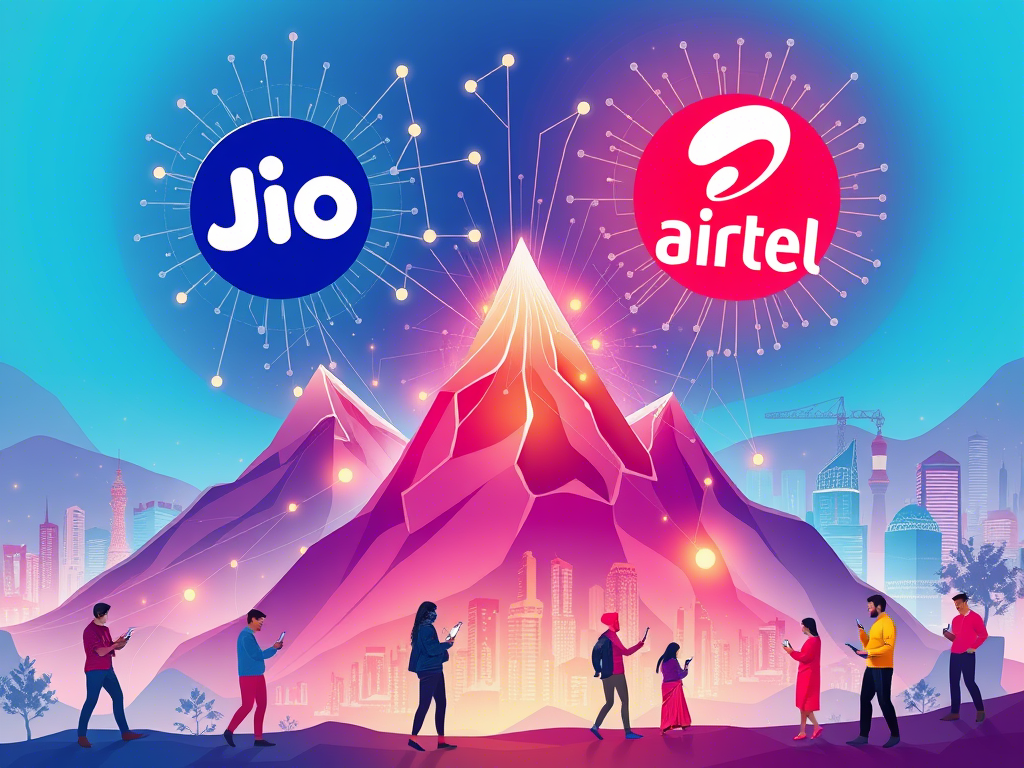The 5G Revolution: Unleashing Transformative Tech Innovation in Jammu and Kashmir and Beyond in 2025
By 2025, the ripple effects of the 5G Revolution are no longer a distant promise but a tangible reality transforming industries and daily life, even in regions like Jammu and Kashmir. While challenges in infrastructure and deployment persist in some areas, the advancements in ultra-fast networks are undeniably powering a wave of tech innovation that promises to reshape how we live, work, and connect in Jammu and Kashmir and across the globe. This 5G Revolution is a foundational shift, not just an incremental upgrade.
Table of Contents

Understanding the 5G Landscape in 2025: A Global and Regional Perspective
The initial hype surrounding 5G has matured into practical applications and a clearer deployment roadmap. By 2025, significant strides have been made in deploying 5G infrastructure across many urban and increasingly rural areas worldwide. For instance, global reports indicate that 5G subscriptions are set to reach 5.3 billion by 2029, highlighting its rapid global adoption (DoFollow to Ericsson Mobility Report). However, in regions like Jammu and Kashmir, the rollout might be more nuanced, with a phased approach focusing initially on key urban centers and gradually expanding. Factors such as diverse terrain, specific security considerations, and the pace of investment in robust infrastructure play a crucial role in the speed and extent of 5G adoption in the region.
Globally, 5G networks are now categorized by their distinct spectrum bands, each offering different characteristics:
- mmWave (millimeter Wave): Offers ultra-high speeds (gigabits per second) and extremely low latency but has limited range and struggles with obstacles. Primarily used in dense urban areas or for specific enterprise applications.
- C-band (mid-band): Provides a good balance of speed (hundreds of Mbps) and coverage, becoming the workhorse for many 5G deployments globally.
- Sub-6 GHz (low-band): Offers the widest coverage, similar to 4G, but with speeds closer to high-end 4G. It’s crucial for broad accessibility, especially in rural or challenging terrains like those found in parts of Jammu and Kashmir.
Despite potential regional variations in the speed and extent of 5G deployment, the underlying technological advancements are universally impactful. The 5G Revolution is defined by its three core pillars: enhanced mobile broadband (eMBB) for massive speeds, ultra-reliable low latency communication (URLLC) for critical applications, and massive machine-type communication (mMTC) for connecting billions of devices. These advantages—its ultra-high speeds, remarkably low latency (the delay in data transfer), and vastly expanded network capacity—are the catalysts driving innovation across diverse sectors, including those vital to Jammu and Kashmir’s socio-economic development.
How the 5G Revolution is Fueling Tech Innovation in Jammu and Kashmir and Globally
The unique capabilities of 5G are the bedrock upon which groundbreaking technologies are being built and existing ones are being significantly enhanced. Here’s a look at how this 5G Revolution is unfolding in Jammu and Kashmir and on a global scale by 2025:
1. Enhanced Mobile Broadband and Immersive Experiences
The most immediate and widely experienced impact of the 5G Revolution is the dramatic improvement in mobile internet speeds. In Jammu and Kashmir, this directly translates to:
- Faster Downloads and Streaming: Downloading massive files, streaming high-definition (4K and 8K) video content, and accessing complex cloud-based services become instantaneous, even on the go. This significantly enhances entertainment, education, and business operations. Imagine seamless access to rich educational content for students in remote areas of Kishtwar or uninterrupted high-resolution video calls for businesses in Srinagar.
- Improved Video Conferencing and Remote Collaboration: Lag-free, high-quality video calls become the norm, facilitating remote work, online education, and more robust communication with family and friends, regardless of their location within a 5G-enabled area. For professionals in Jammu and Kashmir, this means better integration into the global workforce and smoother collaborations. (Internal link: Explore our guide on [Maximizing Productivity with Remote Work Tools].)
- Lag-Free Online Gaming and Cloud Gaming: The incredibly low latency of 5G virtually eliminates the frustrating lag in online multiplayer games. Furthermore, it powers cloud gaming platforms, allowing users to stream graphically intensive games to mobile devices without needing powerful local hardware. This creates a smoother and more immersive gaming experience for enthusiasts in Jammu and Kashmir, potentially fostering a new segment of the digital economy.
- Augmented and Virtual Reality (AR/VR): 5G’s immense bandwidth and minimal latency are crucial for delivering truly immersive and untethered AR and VR experiences. Imagine tourists in Srinagar experiencing historical sites through interactive AR overlays on their phones, offering rich contextual information and immersive visuals. Or consider engineers in Jammu collaborating remotely on architectural designs in a shared VR workspace, feeling a sense of presence despite geographical distance. Globally, this is powering advancements in entertainment, education, training, remote assistance, and even virtual tourism.
2. The Rise of the Internet of Things (IoT) and Smart Cities
The 5G Revolution enables the connection of a far greater number of devices (up to one million devices per square kilometer) than previous generations. This massive machine-type communication (mMTC) capability is accelerating the growth of the Internet of Things (IoT) and the development of smart cities, with profound potential applications for Jammu and Kashmir:
- Smart Agriculture: Farmers in the region, particularly in areas like the Kashmir Valley, can utilize 5G-connected sensors to monitor soil conditions, water levels, crop health, and livestock vital signs in real-time. This leads to more precise irrigation, optimized fertilizer use, early detection of diseases, and improved resource management, boosting agricultural yields and sustainability.
- Smart Transportation: In urban centers like Jammu and Srinagar, 5G can enable connected vehicles to communicate with each other and with traffic infrastructure. This facilitates intelligent traffic management systems, smart parking solutions, and real-time navigation, improving traffic flow, reducing congestion, and enhancing road safety. Public transport can also become smarter with 5G-enabled tracking and information systems.
- Smart Utilities: The deployment of 5G-enabled smart grids can optimize energy distribution, detect faults quickly, and enable remote monitoring and control of power infrastructure, significantly improving the reliability and efficiency of power supply across the region. Similarly, smart water management systems can monitor consumption and detect leaks.
- Smart Homes and Buildings: Residents can benefit from interconnected smart appliances, advanced security systems, and intelligent energy management solutions, offering greater convenience, energy efficiency, and enhanced safety within their homes and workplaces.
- Environmental Monitoring: 5G-connected sensors can be deployed to monitor air quality, water pollution levels, and even seismic activity in vulnerable areas, providing critical data for environmental protection and disaster preparedness. This is especially relevant given the unique ecological landscape of Jammu and Kashmir. (Internal link: Read more about [Innovations in Environmental Monitoring].)
- Global Impact: The 5G Revolution is the critical backbone for large-scale IoT deployments across various industries worldwide, including manufacturing (smart factories with automated production lines), logistics (connected supply chains with real-time tracking), and healthcare (remote patient monitoring, smart hospitals).
3. Revolutionizing Industries with Ultra-Reliable Low Latency Communication (URLLC)
5G’s URLLC capabilities, characterized by extremely low latency (as low as 1 millisecond) and ultra-high reliability (99.999%), are opening doors for transformative applications in critical industries, with significant potential relevance for specific sectors in Jammu and Kashmir:
- Remote Healthcare (Telemedicine and Telesurgery): The 5G Revolution enables advanced telemedicine, allowing specialists in urban centers like Jammu or even major Indian cities to consult with patients in remote areas of Jammu and Kashmir via high-definition video with minimal delay. More critically, it holds the potential for telesurgery, where highly skilled surgeons could guide or perform intricate procedures remotely using robotic arms, expanding access to expert medical care in underserved regions. This could be a game-changer for healthcare accessibility in the challenging terrains of J&K. (Internal link: Discover more about [The Future of Telemedicine in Remote Areas].)
- Autonomous Vehicles and Drones: While large-scale autonomous vehicle deployment might still be further out for Jammu and Kashmir due to infrastructure and regulatory factors, 5G’s low latency is crucial for enabling the real-time communication and decision-making required for self-driving cars, drones, and delivery robots. This could eventually impact logistics, surveillance, and even emergency response within the region. Imagine drones powered by 5G delivering medical supplies to remote villages or assisting in disaster assessment.
- Industrial Automation and Robotics: 5G-enabled robots and automated systems in manufacturing facilities (if present or developing in the region, particularly in light industries or agriculture processing) can operate with greater precision, responsiveness, and safety. This leads to increased efficiency, higher productivity, and the potential for new types of manufacturing. Globally, this is accelerating the development of “Industry 4.0” and smart factories.
- Mission-Critical Communications: First responders, law enforcement, and emergency services in Jammu and Kashmir can benefit immensely from reliable, low-latency 5G communication for coordinating efforts during critical situations, natural disasters, or security operations. This ensures clear, immediate communication when every second counts.
4. Fixed Wireless Access (FWA) as a Broadband Alternative for the Digital Divide
In many areas of Jammu and Kashmir where laying physical fiber optic cables is challenging, expensive, or cost-prohibitive due to terrain or logistical issues, 5G-based Fixed Wireless Access (FWA) offers a viable and high-speed broadband alternative for homes and businesses. FWA essentially uses 5G cellular technology to deliver broadband internet to a fixed location.
This capability of the 5G Revolution can bridge the digital divide in remote and rural communities across Jammu and Kashmir, providing reliable internet connectivity where traditional wired broadband is unavailable or impractical. This enables access to online education, e-commerce opportunities for local artisans and businesses, remote work possibilities, and critical digital government services. Globally, FWA is playing a significant role in expanding broadband access in underserved rural and remote regions, demonstrating 5G’s profound social impact. (Internal link: Read our insights on [Bridging the Digital Divide: Strategies for Rural Connectivity].)
5. The Convergence of AI and 5G: Intelligent Networks and Smart Applications
The combination of Artificial Intelligence (AI) and 5G is creating powerful synergies, often referred to as “AI on the Edge.” AI algorithms require massive amounts of data to learn and operate effectively, and 5G’s high bandwidth facilitates the rapid, real-time transfer of this data. Conversely, AI can optimize 5G networks for better performance and efficiency. In Jammu and Kashmir and globally, this convergence is enabling:
- Smarter Analytics: Real-time data collected through 5G-connected IoT devices can be immediately analyzed by AI at the edge of the network (closer to the data source) to provide actionable insights for various applications, from optimizing traffic flow in Srinagar to predicting agricultural yields in rural districts, or monitoring tourist flows.
- Enhanced Automation: AI-powered robots, drones, and autonomous systems can leverage 5G for faster and more reliable communication with central AI brains, leading to more efficient and sophisticated automation in industries, public safety, and logistics.
- Personalized Experiences: AI algorithms can use vast amounts of real-time data transmitted over 5G networks to deliver more personalized content, services, and recommendations to users, from adaptive educational content to tailored tourism experiences.
- AI-Driven Network Optimization: AI can be used to manage and optimize 5G networks themselves, predicting traffic patterns, allocating resources efficiently, and even self-healing network issues, leading to more reliable and efficient services for users across Jammu and Kashmir. (Internal link: Explore [The Role of AI in Next-Gen Network Management].)
6. Transforming Education and Skill Development with 5G
The 5G Revolution holds immense potential to democratize access to high-quality education and foster skill development, particularly in regions like Jammu and Kashmir:
- Enhanced Remote Learning: High-speed, low-latency 5G connections make remote and online learning more engaging and effective. Students in remote villages can access interactive lessons, participate in virtual labs, and stream educational content without buffering.
- VR/AR in Classrooms: Immersive AR/VR applications, powered by 5G, can transform traditional classrooms into dynamic learning environments. Students can explore historical sites virtually, conduct simulated science experiments, or dissect virtual organs, offering hands-on experiences regardless of physical resources.
- Access to Global Educational Resources: 5G facilitates seamless access to massive open online courses (MOOCs), digital libraries, and virtual collaboration platforms, connecting students and educators in Jammu and Kashmir with global learning opportunities and experts.
- Vocational Training: VR/AR simulations powered by 5G can provide realistic and safe training environments for vocational skills, from operating heavy machinery to performing complex medical procedures, addressing skill gaps in various sectors.
7. Powering Tourism and Cultural Preservation in Jammu and Kashmir
Given the rich cultural heritage and breathtaking natural beauty of Jammu and Kashmir, the 5G Revolution can play a pivotal role in enhancing tourism and cultural preservation:
- Virtual Tourism and AR-Guided Tours: High-quality 5G connectivity enables seamless virtual tours for potential visitors worldwide, showcasing the region’s attractions. On-site, AR applications can overlay historical information, local narratives, and interactive elements onto real-world landmarks in Srinagar, Jammu, or Leh, offering a deeply enriched tourist experience. (Internal link: Discover [Innovative Technologies Enhancing Tourist Experiences].)
- Enhanced Visitor Experience: Real-time translation services, instant access to local information, and high-speed data for sharing experiences will make travel more convenient and enjoyable for tourists.
- Live Streaming Cultural Events: 5G’s bandwidth allows for high-definition live streaming of local festivals, traditional performances, and cultural events to a global audience, promoting the region’s unique heritage and fostering cultural exchange.
- Digital Archiving and Preservation: 5G can facilitate the rapid transfer and processing of large datasets, aiding in the digital archiving and preservation of historical documents, artifacts, and intangible cultural heritage.
8. Impact on Enterprise and Industry in Jammu and Kashmir
The 5G Revolution will empower various industries within Jammu and Kashmir by enabling greater connectivity and automation:
- Logistics and Supply Chain: Real-time tracking of goods, optimized route planning, and drone deliveries powered by 5G can significantly improve the efficiency and transparency of supply chains within the region, crucial for industries relying on the timely movement of goods.
- Manufacturing (if applicable): While large-scale manufacturing might be limited, smaller industrial units or processing plants can adopt 5G for connected machinery, predictive maintenance, and quality control, increasing efficiency and reducing downtime.
- Mining and Construction: In areas with mining or significant construction activities, 5G can enable remote operation of heavy machinery, improving safety, efficiency, and precision in hazardous environments.
- Retail: Enhanced in-store experiences with AR, faster POS systems, and real-time inventory management can transform local retail businesses.
9. Security and Privacy in the 5G Era
As the 5G Revolution connects more devices and carries more sensitive data, the importance of robust security and privacy measures becomes paramount. This is a global concern with specific implications for regions like Jammu and Kashmir:
- Increased Attack Surface: The vast number of connected IoT devices creates a larger potential attack surface, requiring advanced cybersecurity protocols.
- Network Slicing Security: While 5G’s network slicing offers isolation, ensuring the security of each slice is critical, particularly for mission-critical applications. (DoFollow to GSMA on 5G Security Guidance).
- Data Privacy: With more data being generated and transmitted, ensuring compliance with data privacy regulations (like India’s upcoming data protection laws) is crucial.
- Regional Specifics: Given the geopolitical sensitivity of Jammu and Kashmir, ensuring the resilience and security of its 5G infrastructure against cyber threats is a heightened priority, requiring collaboration between network operators and government agencies.
10. Policy & Regulatory Environment for 5G in India/Jammu and Kashmir
The successful deployment and utilization of the 5G Revolution also heavily rely on a supportive policy and regulatory environment.
- Spectrum Auctions: Timely and fair allocation of 5G spectrum by the Department of Telecommunications (DoT) in India is fundamental for operators to roll out services efficiently. The recent auctions have paved the way for broader deployment.
- Ease of Doing Business: Streamlining processes for tower installation, right-of-way permissions, and local clearances is crucial to accelerate infrastructure development, especially in challenging terrains.
- Public-Private Partnerships: Collaboration between the government, network operators, and technology providers is vital for addressing infrastructure gaps and driving innovation in specific sectors. Initiatives like the Gati Shakti master plan (DoFollow to official website) aim to accelerate infrastructure development across India, benefiting regions like Jammu and Kashmir.
- Skill Development Programs: Government initiatives focusing on upskilling the workforce in 5G technologies, AI, and IoT will be essential to fully harness the benefits of this new era. (Internal link: Read about [Government Initiatives for Digital Skill Development in India].)
Challenges and the Path Forward in Jammu and Kashmir
While the potential of the 5G Revolution in Jammu and Kashmir is immense, several challenges need to be addressed for its widespread and impactful adoption:
- Infrastructure Development: Deploying the necessary dense 5G infrastructure, including small cells, fiber optic backhaul, and robust energy supply, across the diverse and often challenging terrain of the region requires significant sustained investment and complex logistical planning. This includes overcoming geographical barriers in mountainous areas.
- Spectrum Allocation and Availability: Ensuring adequate and timely allocation of 5G spectrum by regulatory authorities to all operators is crucial. While national auctions have happened, localized frequency planning and interference management in specific regions need attention.
- Security Concerns: Addressing the heightened security vulnerabilities associated with 5G networks, especially given the sensitive nature of the region, is paramount. This includes safeguarding critical infrastructure and ensuring data integrity.
- Affordability and Access: Ensuring that 5G services and compatible devices are affordable and accessible to a wider population, including those in rural and lower-income areas, is essential for equitable digital transformation. Bridging the digital divide requires not just infrastructure but also affordability.
- Skills Development: Fostering a skilled workforce capable of deploying, managing, maintaining, and innovating with 5G technologies, AI, and IoT is crucial for maximizing its benefits and creating local employment opportunities. Investing in STEM education and vocational training programs will be key.
- Policy Implementation: Translating national 5G policies into effective regional implementation, addressing local challenges, and ensuring smooth coordination between central and local authorities.
o truly harness the power of the 5G Revolution, local businesses and individuals also need robust and reliable web infrastructure. For those in Jammu and Kashmir looking to establish or enhance their online presence, services from local providers are crucial. Yaam Web Solutions, for instance, offers a comprehensive range of web hosting services, from shared and VPS to dedicated servers, ensuring that businesses of all sizes can find the perfect solution to support their digital endeavors and leverage the speed and capabilities of the evolving 5G networks. You can explore their offerings at https://yaamwebsolutions.com/services.
Despite these challenges, the momentum behind the 5G Revolution is undeniable. As infrastructure develops, spectrum is optimally utilized, and the cost of 5G-enabled devices decreases, Jammu and Kashmir stands to gain significantly from this technological revolution. Strategic investments, supportive policies, and a continuous focus on developing relevant skills will pave the way for the region to harness the power of 5G and participate robustly in the global wave of tech innovation in 2025 and beyond.
Conclusion: Embracing the 5G Future in Jammu and Kashmir
The 5G Revolution is not just about faster internet speeds on our phones. It’s a fundamental shift in network capabilities that is acting as a powerful catalyst for technological innovation across industries and societies. While the pace and specifics of its adoption may vary in regions like Jammu and Kashmir due to unique local factors, the transformative potential remains the same. The opportunities it presents for enhancing communication, driving economic growth, improving public services, and fostering new new industries are immense.
By strategically addressing the remaining challenges and proactively embracing the opportunities that 5G presents, Jammu and Kashmir can position itself to be a significant beneficiary of this exciting future. Leveraging ultra-fast networks, the region can power economic growth, improve public services, enhance connectivity, and fundamentally improve the lives of its citizens in 2025 and for generations to come. The journey of the 5G Revolution in Jammu and Kashmir is just beginning, and its impact promises to be profound and lasting.






